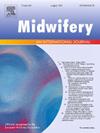Womenʼs reflections on induction of labour and birthing interventions and what they would do differently next time: A content analysis
IF 2.6
3区 医学
Q1 NURSING
引用次数: 0
Abstract
Background
Induction of labour (IOL) and birth intervention is increasingly conducted in Australia, and rates of maternal dissatisfaction and birth trauma are also on the rise.
Methods
The Birth Experience Study (BESt) national survey was conducted to explore women's experiences of birthing in Australia. This content analysis categorises components pertaining to IOL, and women's responses to the open-ended question: “Would you do anything different if you were to have another baby?”
Findings
In total, 591 responses on IOL resulted in 819 coded comments being coded into multiple categories/subcategories. In the first main category ‘increasing the chance of a spontaneous labour next time by resisting IOL’ (93.3 %), three subcategories were identified: ‘I would resist the pressure or refuse, especially if not a good indication’ (54.8 %, 419); ‘I will await spontaneous onset or delay the IOL until later’ (25.0 %, 191); and ‘I will be better informed next time’ (20.2 %, 154). In the second main category ‘accepting IOL was necessary or desirable’ (6.7 %), two subcategories were identified: ‘my IOL was justified or desired’ (38.2 %, 21) and ‘my IOL was justified or desired, but if there is a next time, I'd want more say in what happens’ (61.8 %, 34).
Conclusion
Overwhelmingly women expressed a desire to avoid IOL, along with the intention to: resist pressure, allow more time for spontaneous labour onset, and arm themselves with more knowledge to advocate against non-medically indicated justifications. Amongst the minority accepting of their previous IOLs, the majority stated wanting more say regarding when and how IOL was conducted.
妇女对引产和分娩干预的反思以及她们下次会采取的不同做法:内容分析
背景引产(IOL)和分娩干预在澳大利亚越来越普遍,产妇的不满意度和分娩创伤率也在上升。本内容分析对与 IOL 相关的内容以及妇女对开放式问题的回答进行了分类:"结果总共有 591 个关于 IOL 的回答,其中 819 条评论被编码为多个类别/子类别。在第一个主要类别 "通过抵制 IOL 增加下次自然分娩的机会"(93.3%)中,确定了三个子类别:我会抵制压力或拒绝,尤其是在没有良好指征的情况下"(54.8%,419 人);"我会等待自然分娩或将人工晶体植入推迟到以后"(25.0%,191 人);以及 "下次我会更好地了解情况"(20.2%,154 人)。在第二大类 "接受人工晶体植入术是必要或可取的"(6.7%)中,确定了两个子类:结论绝大多数妇女表示希望避免 IOL,并打算:抵制压力,为自然分娩留出更多时间,用更多知识武装自己,反对非医学指征的理由。在少数接受之前人工流产的产妇中,大多数人表示希望在何时及如何进行人工流产方面拥有更多的发言权。
本文章由计算机程序翻译,如有差异,请以英文原文为准。
求助全文
约1分钟内获得全文
求助全文
来源期刊

Midwifery
医学-护理
CiteScore
4.50
自引率
7.40%
发文量
221
审稿时长
13.4 weeks
期刊介绍:
Midwifery publishes the latest peer reviewed international research to inform the safety, quality, outcomes and experiences of pregnancy, birth and maternity care for childbearing women, their babies and families. The journal’s publications support midwives and maternity care providers to explore and develop their knowledge, skills and attitudes informed by best available evidence.
Midwifery provides an international, interdisciplinary forum for the publication, dissemination and discussion of advances in evidence, controversies and current research, and promotes continuing education through publication of systematic and other scholarly reviews and updates. Midwifery articles cover the cultural, clinical, psycho-social, sociological, epidemiological, education, managerial, workforce, organizational and technological areas of practice in preconception, maternal and infant care.
The journal welcomes the highest quality scholarly research that employs rigorous methodology. Midwifery is a leading international journal in midwifery and maternal health with a current impact factor of 1.861 (© Thomson Reuters Journal Citation Reports 2016) and employs a double-blind peer review process.
 求助内容:
求助内容: 应助结果提醒方式:
应助结果提醒方式:


